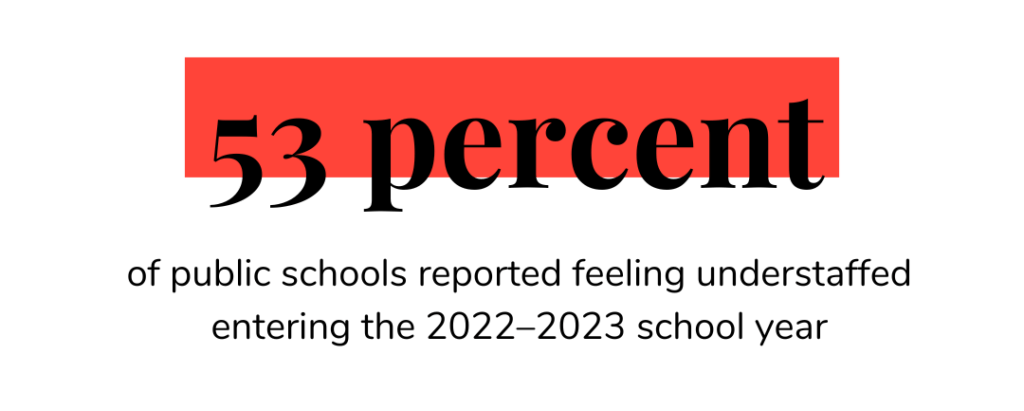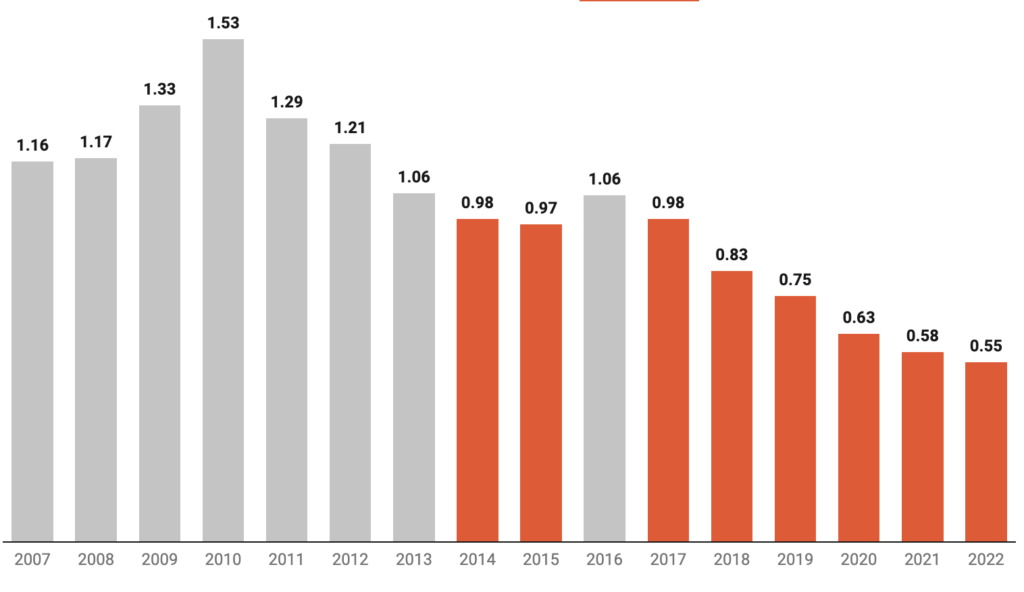Teacher Recruitment Statistics, Challenges, and Solutions
You’ve seen the headlines. You’ve felt the impacts. Data and perspectives vary, but the fact remains that there aren’t enough qualified teachers to go around right now—especially in critical subject areas like special education and STEM subjects. Even the US Department of Education has sounded the alarm.
Understaffed schools have a profound impact on the quality of education, increase socioeconomic gaps, and, put simply, harm students. According to RAND, “teachers matter more to student achievement than any other aspect of schooling.”
Current State of the Teacher Shortage
In an August 2022 survey of education professionals, 53 percent of public schools reported feeling understaffed entering the 2022–2023 school year. It’s inspired a lot of chatter on how to attract and inspire new teachers—and motivate the educators we already have.

While much of the recent discussion on the subject has blamed pandemic burnout as a primary driver for the teacher shortage affecting many American schools and school districts, the reality is that the pandemic worsened a problem that existed long before COVID-19 entered the scene.
An Economic Policy Institute report back in 2019 found that “the share of schools that were trying to fill a vacancy but couldn’t tripled from the 2011–2012 to 2015–2016 school years (increasing from 3.1 to 9.4 percent), and in the same period the share of schools that found it very difficult to fill a vacancy nearly doubled (from 19.7 to 36.2 percent).”
The severity of the teacher shortage varies from place to place and subject to subject, but it is real, and its impacts cannot be ignored. And for administrators with unfilled teaching positions in their schools, it’s critical to correct for these trends quickly to keep operations running smoothly for teachers, students, and communities.
Why is There a Teacher Shortage?
According to the US Bureau of Labor Statistics, approximately 10.6 million educators were working in January 2020. As of January 2022, that number was down to 10 million—a loss of roughly 600,000 teaching professionals in the first two years of COVID-19.
In particular states and communities, the reasons for the teacher shortage are different. But, across the country, teachers are retiring earlier and switching careers at higher rates than before. The most common reasons are due to disputes about pay, lack of growth opportunities, and excessive workloads.
Low pay reducing interest in teaching as a career 1
Quick Stats on Teacher Pay:
- In 2018, teachers’ weekly wages were 21.4 percent lower than non-teachers’
- During the 2015-2015 school year, 59 percent of teachers took on additional paid work to supplement their salaries
School boards’ budgets are normally tight but can incentivize teachers in other ways. Offering grants and stipends to teachers that take on extra activities (team lead, club coordinator, or sports coach) can be a good way to increase teachers’ salaries.
Fewer qualified applicants for teacher vacancies 2
Quick Stats on Teacher Candidates vs Vacancies:
- Only 5 percent of surveyed students taking the ACT in 2014 reported interest in education as a career
- That’s a 29 percent decrease from 2010
- Enrollment in teacher preparation programs dropped more than 40 percent from 2009 to 2014
In their recent webinar, Frontline Education noted that the same number of teacher positions are posted year over year, but recently teacher candidate numbers have been falling. Teacher pipeline programs and mentorship programs can combat these falling numbers. Investing time and resources in students studying to become teachers helps build loyalty for your school and provides you with a larger teacher candidate pool.
Using video interviewing software can help you reach more applicants for your unfilled teacher positions. One interviewstream client has gone from screening 3-5 candidates per position to screening 13+ candidates. Shortening screening times means they are able to screen more candidates and make a better informed decision on who is the best teacher for the position.
Lack of ongoing training, professional development, and career support 3
Quick Stats on Teacher Career Support:
- 1 in 4 or fewer teachers had access to university courses, workshops, or visits to other schools to aid in ongoing development
- 1 in 10 teachers received reimbursement for college tuition to further their education
- 1 in 5 teachers in high-poverty schools had no mentor support
Providing growth opportunities for teachers keeps them engaged. Even if they aren’t looking to continue teaching, they could grow into becoming a principal, superintendent, or HR administrator for your school. Offering university stipends and continuing education also gives teachers opportunities to earn more.
Teacher Recruitment Statistics You Should Know
Accounting for layoffs of support staff when schools were closed at the start of the pandemic, studies found that the K-12 education labor market in the US shrank by 9 percent from March to May 2020.
After many of those jobs recovered, voluntary turnover and difficulty filling open roles became more acute. For example, by March 2022, staffing still lagged 4 percent below pre-pandemic levels.
According to the US Bureau of Labor Statistics, approximately 10.6 million educators were working in January 2020. As of January 2022, that number was down to 10 million—a loss of roughly 600,000 teaching professionals in the first two years of COVID-19.
As the school year began in 2022, federal data showed a shortage in the pipeline of new teachers and school staff. Additionally, 69 percent of public schools reported too few qualified teacher candidates being the primary barrier to filling open roles.
Teacher Hiring vs Open Teaching Positions Statistics:4
- As of June 1, 2022, there were 300,000 job openings in public education—but only 200,000 new hires.
- The ratio of hires to job openings in these schools has been less than 1 since 2017
- 30 percent fewer students completed teacher preparation programs in 2019-2020 compared to 2008-2009
- Between 2014 and 2018, the share of Americans who would not want their children to become teachers outpaced those that would for the first time

Current Challenges with Teacher Retention
More teachers exited schools after the 2021-2022 school year than average in at least eight states, according to data from Hawaii, Louisiana, Maine, Maryland, Mississippi, North Carolina, South Carolina, and Washington. Though data is limited, the pattern is so consistent—the highest turnover rate in at least five years—that it’s reasonable to conclude the same problem exists in other states.
By the numbers, the average turnover rate between those states was 2 percent higher than typical pre-pandemic levels. That means in a typical school with 50 teachers, one more than usual exited in 2022.
Quick Stats on Teacher Retention:
- Teacher satisfaction is at a 50-year low according to the most recent data.
- 7 in 10 school leaders say pay raises would help them retain their teachers
- 84 percent of teachers in an EdWeek study said teaching now is more stressful than before the pandemic
- Because 80 percent of teachers are women, childcare difficulties related to the pandemic and caregiver shortages have had an impact on many educators’ career decisions
- 1 in 3 teachers said retirement benefits were a big factor in their decision to stay or go
Reasons Teachers Give for Voluntary Teacher Turnover
- Only 11 percent of teachers felt supportive administrators were one of the biggest factors in their decisions to stay in their jobs
- 43 percent said less paperwork and fewer administrative duties would encourage them to stay
- 80 percent of teachers report unfilled job openings have increased their workloads9
- Exiting teachers also cite a lack of autonomy over their lesson plans, being overburdened with disciplinary responsibilities, and disrespectfulness from students and parents
Experts estimate that teacher turnover costs as much as $8.5 billion each year in US schools. Each individual loss can mean a school takes a financial hit of 150% of the departing teacher’s salary. As an administrator or educator, how can you help overcome this very real challenge for your school, students, and local community?
Solutions to the Teacher Shortage and Teacher Retention Problems
Addressing the most popular complaints that lead to turnover is the obvious answer to addressing teacher retention. That means offering higher pay, better benefits, and increased autonomy for educators in their classrooms.
Create Growth Opportunities for Teachers to Aid Retention
Supporting a stronger developmental career path will also help. Instituting mentorship programs, funding ongoing education, and rewarding teachers who put in extra effort within and beyond their schools will help develop stronger, more qualified teachers who feel more motivated to stay—and empowered to help their students succeed in a big way.
Retain Teachers With Additional Benefits
Getting creative with job perks will also help districts and schools stand out in the competition for talent. For example, some states have introduced housing benefits for teachers; others are experimenting with four-day school weeks and job-sharing programs.
A common refrain from teachers is a longing for more flexibility, especially in a world where remote work is so prolific in other industries. Exploring blended learning models, more experiential learning opportunities for students, and support that goes beyond the classroom could help a lot. Simplifying the busy work goes a long way in aiding morale, too.
Use Hiring Technology to For Incoming and Current Teachers
Technology can support these efforts efficiently and in ways that are accessible and repeatable for teachers across schools and subjects. For example, Frontline Education is a popular and robust platform for tackling many of these use cases.
Recruit Strong Teacher Candidates To Decrease Turnover
Another area ripe for improved efficiency and flexibility is recruiting. Making the recruiting process as straightforward and productive as possible—for hiring teams and applicants—is key to increasing your teacher talent pool.
Take a moment to audit your teacher recruiting practices by asking yourself the following questions:
- Is our school reaching applicants from a wide geographical area, or are we targeting local sources only?
- Are we enabling on demand video interviews to better accommodate applicants?
- Do we have the right interview questions for teachers lined up to ensure a good fit and help them feel seen and empowered to do their best work?
- Are we focusing not just on general teacher interview questions, but also more focused interview questions for areas of extra need, such as special education, math, and literacy?
- Do we make applying and interviewing as easy and seamless as possible for candidates?
- Do we enable collaboration within our own school, to empower administrators and teachers to work together in finding the best candidates?
- Is our recruiting workflow repeatable, digital, and as efficient as possible?
Using the right recruiting technology to hire teachers is a great way to improve your answers to those questions and streamline your K-12 hiring practices.
Backing those good habits up with creative retention and referral incentives—whether they’re in the form of cash, tuition reimbursement, extra time off, formal recognition, or something else—is a win-win strategy for attracting and keeping more qualified, happier, and more effective teachers for your school.
The State of Teacher Recruitment Going Forward
The state of teacher recruitment looks grim, but by analyzing challenges and solutions – it’s solvable with a little help. Having enough support for teachers, whether that support is interviewing software or additional administrators, goes a long way to preventing turnover.
Increasing pay (or stipends, or grants), giving teachers growth opportunities, and making sure your teacher applicant pool is large enough to be able to hire the best candidates for your students will also help your school district retain and recruit great teachers for your students.
If you need help recruiting, fill out this form and we’ll get in contact with you to show you how other K-012 school districts have had success using video interviews and interview scheduling to expand their candidate pools and hire their top candidates.
About The Author
Caroline Chessia is the Marketing Operations Specialist at interviewstream. She loves color-coordinated graphs, hiking in the mountains, and every dog she meets—especially the Golden Retrievers.
